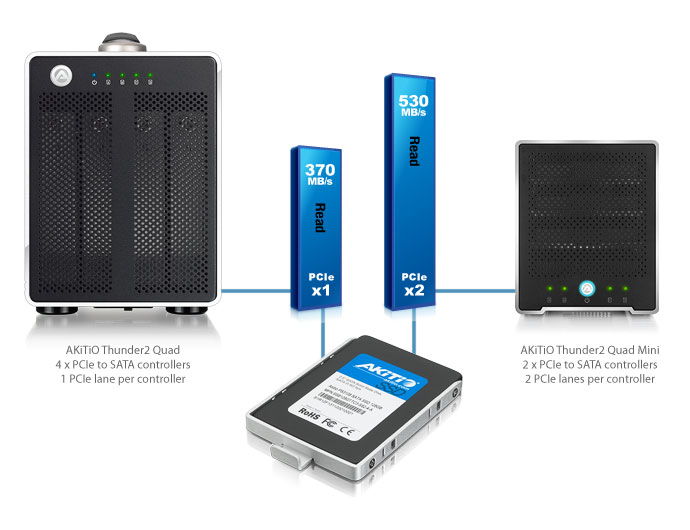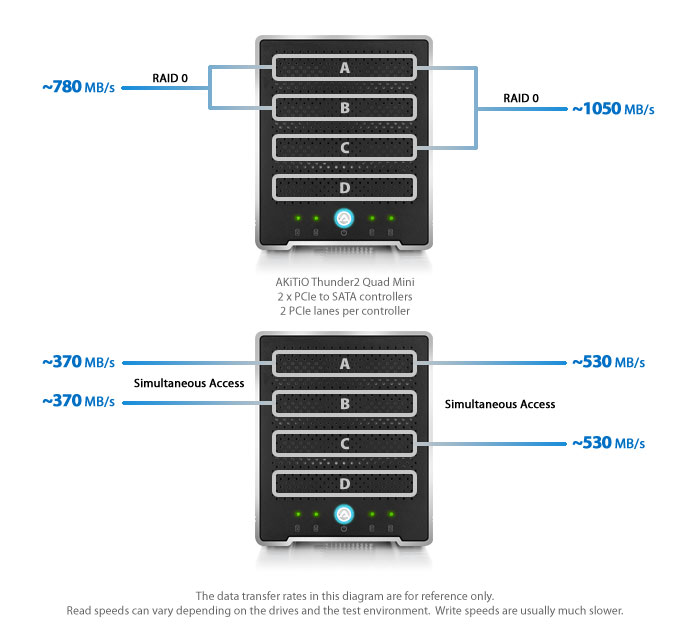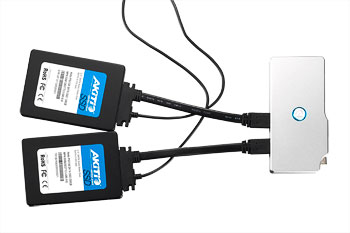Solid state drives (SSDs) provide faster data transfer rates than mechanical hard disk drives (HDD's) but how fast can an SSD with a SATA interface really go and what is needed to achieve the best possible speeds in an external storage enclosure?
A single SSD with a SATA 6Gb/s interface, also known as SATA-III or SATA 3, can deliver speeds of about 500-550MB/s. This means that the storage enclosure should have a USB 3.1 Gen 2 interface at 10Gbps or a Thunderbolt interface to provide sufficient bandwidth. However, when it comes to Thunderbolt enclosures, not all are built the same way and if you plan on getting the most out of a single SSD, you need to make sure that the SATA controller also provides enough bandwidth to run at full SATA 6Gb/s speeds.
PCIe to SATA controller
The SATA controller in the Thunderbolt enclosure connects to the computer through PCI Express (PCIe). One Gen-2 PCIe lane has a bandwidth of 5Gb/s, so if the SATA controller makes use of only one PCIe lane, the performance of the SSD is limited to about 370MB/s. These are still good speeds but not the maximum the SSD can reach. If, on the other hand, the SATA controller makes use of two Gen-2 PCIe lanes, the SSD can run at full 6Gb/s speeds and deliver transfer rates of over 500MB/s.
Here are some of the AKiTiO Thunderbolt products that make use of two Gen-2 PCIe lanes per controller and can therefore deliver top speeds for single SSDs:
- AKiTiO Thunder2 Duo Pro
- AKiTiO Thunder2 Quad Mini
- AKiTiO Thunder3 Duo Pro
- AKiTiO Thunder3 Quad Mini
- AKiTiO ThunderGo
- AKiTiO Thunder SATA Go
1 PCIe lane vs 2 PCIe lanes
What does that mean for other Thunderbolt products that only use one PCIe lane? The answer to that is that it depends on the amount of drives and if a RAID set is created with those drives or not. For example, the AKiTiO Thunder2 Quad and the AKiTiO Thunder3 Quad were created mainly for 3.5" drives and use only one PCIe lane per drive. If you install a single SSD, it will therefore max out at around 370MB/s.
When you install four SSDs and create a RAID 0 set, the bottleneck will be around 1375MB/s for four Gen-2 PCIe lanes. For the Thunder2 Quad, this is also the bottleneck of the Thunderbolt 2 interface. For the Thunder3 Quad, even though the Thunderbolt 3 interface is capable of faster speeds than that, due to the SATA Controller, the bottleneck is still only 1375 MB/s.
For a storage enclosure designed only for one drive like the AKiTiO ThunderGo, having one or two PCIe lanes makes a big difference. In that case, it can mean an increase in transfer rates of around 160MB/s, which can definitely be felt when transferring and accessing the data on that drive.

AKiTiO Thunder2 Quad Mini & AKiTiO Thunder3 Quad Mini
Last but not least, a tip for users of our AKiTiO Thunder2 Quad Mini and the AKiTiO Thunder3 Quad Mini, which are based on two PCIe to SATA controllers. To get the most out of only two SSD's, install one drive in slot A (or B) and one drive in slot C (or D). That way, each drive gets two PCIe lanes and can run at full SATA 6Gb/s speeds. In the real world, this means that you can get over 500MB/s for a single drive or over 1000MB/s for two drives in a RAID 0 set.
When you stripe four SSDs, the maximum transfer rate with four Gen-2 PCIe lanes and the Thunderbolt 2 interface of the Thunder2 Quad MIni is about 1375 MB/s. For the Thunder3 Quad Mini, even though the Thunderbolt 3 interface is capable of speeds faster than that, due to the SATA controllers, the bottleneck is still only about 1480 MB/s.



